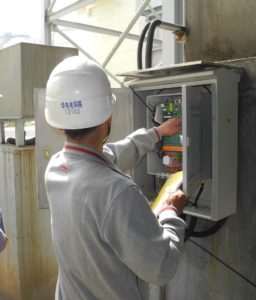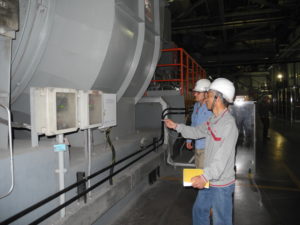 By: Burt Hurlock, CEO, Azima DLI
By: Burt Hurlock, CEO, Azima DLI
The argument against permanently installed online condition monitoring solutions has been universally financial. The argument is that a technician with a handheld data collector can cover a lot more ground, test many more machines, and go to where the trouble is far most cost efficient, while the sunk cost of a permanently installed vibration sensor may take years to justify itself, if ever, because machines selected for permanently installed online monitoring may take years to show signs of deterioration. The only way to test the argument is to run the numbers.
The Fully Loaded Cost of Online Monitoring
 Imagine a plant with fifty machines that require monitoring. Each machine has three channels from which data is required, and that the installed cost per triaxial channel of an online solution is approximately $1,000. Assume further that the monthly cost of analysis per monitored machine averages $35 (a number that may vary widely depending on the complexity of the machine). The financial analysis might conclude that the net present value cost of a fully installed and monitored online solution over five years is in the range of $234,000.
Imagine a plant with fifty machines that require monitoring. Each machine has three channels from which data is required, and that the installed cost per triaxial channel of an online solution is approximately $1,000. Assume further that the monthly cost of analysis per monitored machine averages $35 (a number that may vary widely depending on the complexity of the machine). The financial analysis might conclude that the net present value cost of a fully installed and monitored online solution over five years is in the range of $234,000.
Imagine the same plant with fifty machines, a reasonable number from which to expect an experienced technician using a handheld data collector to collect data over an average work day. Assume the technician requires one work day to collect data and two more days to analyze and publish his findings and repair recommendations. Assume further that data is collected monthly, and that the fully loaded cost (salary + benefits) of a technician is $1,200 per day. The financial analysis might conclude that the net present value cost of a traditional route based PdM program over five years is in the range of $231,000.
Rudimentary financial analysis reaches the surprising conclusion that over five years, a permanently installed online PdM program and a traditional route based program for a relatively small, fifty machine program cost about the same, assuming the route based program is performed by a third party expert rather than an in-house employee.
In-House Vs. Outsourced Route Based Programs
A route based program executed by an in-house employee may offer a material labor cost saving over an outsourced route based program; but what if the analyst leaves, gets sick or promoted, or fails to perform consistently because he’s overtasked or has personal or professional distractions? What if deteriorating machine health calls for more frequent machine testing to track a rapidly deteriorating situation? Does the employee-run, route based program retain the same cost advantage? No.
As soon as any of the labor assumptions under the route based model deviate due to any number of unpredictable circumstances the cost of the employee-run, route based program rises, either because conditions require more testing and analysis and therefore more labor, or because higher operating priorities distract from the continuity of the PdM program and the quality of analysis and repair and maintenance suffers. If the PdM program stalls entirely and requires restarting, the program requires still more unplanned investment which may include recruiting and training.
number of unpredictable circumstances the cost of the employee-run, route based program rises, either because conditions require more testing and analysis and therefore more labor, or because higher operating priorities distract from the continuity of the PdM program and the quality of analysis and repair and maintenance suffers. If the PdM program stalls entirely and requires restarting, the program requires still more unplanned investment which may include recruiting and training.
The cost of route based programs (both in-house and outsourced) rise even more with the size of PdM programs, and not only because the potential for unpredictable circumstances rises with machine census, but because so much of the labor rate in route based programs is consumed by testing, 80% of which will find no trace of mechanical faults. The same financial analysis performed on PdM programs with 500 or 1,000 machines requires higher assumptions for labor associated with testing, machine test review, and analysis; whereas online solutions, while requiring more one-time capital investment, incur neither the same repetitive escalation in labor costs associated with more testing, nor the uncertainties associated with the performance and retention of key employees.
Route Based Vs. Online Programs at Scale (More Than 100 Machines)
Buyers of PdM solutions often fixate on one-time capital costs that are incurred upfront, and overlook recurring, long term operating costs, because those are tomorrow’s problems, not today’s. It’s a kick-the-can down the road financial decision that often makes near-term economic sense, but often underestimates the risks and costs of sustaining long-term programs.

Where online programs excel is in the consistency with which they gather high quality data, and the flexibility they offer to adjust the frequency of data collection. With no additional tasking besides a few key strokes, online systems can be directed to perform more tests and capture data around transient events that analysts running route based programs may not be available to monitor. Not only do online solutions eliminate the labor and data quality variables associated with manual testing, they leverage automated fault detection techniques such as rule based expert systems and alarm banding to all but eliminate manual reviews of perfectly healthy data and focus costly analyst labor time on detected faults.
That is not to say that highly proficient analysts cannot match the performance of online solutions for small PdM programs over the medium term, as long as they perform with the same mechanical precision as the online system, take consistently high quality data on schedule, and review it with the same dispassionate eye as the diagnostic screening tools that customarily accompany online monitoring solutions. But the chances the same analyst will being doing the same job with the same proficiency in five years is low, and even lower in the case of large scale programs.
What often appears to be a compelling economic case from the vantage point of procurement today may lose its appeal in the long run, with respect to short and long-term spend, sustainability, and the quality of data collection, analysis, and repair and maintenance performance, as well as the scalability, continuity and labor efficiency. The arguments for online PdM solutions should not be misconstrued as arguments against the reliability of labor. To the contrary, online solutions absorb the mundane, mind-numbing duties of repetitive data collection that are by their nature hard to sustain, and supply labor with the tools to expand its influence over the management and maintenance of more machines.
While today’s capital outlay for an online PdM solution may seem higher than for a route based alternative, rudimentary financial analysis (that does not anticipate costs associated with the failures and restarts common to route based programs) finds that PdM buyers should be indifferent to which path they chose, based on a straight-forward net present value cost analysis of even a relatively small, fifty machine program. As the size of a PdM program expands, the advantage shifts more rapidly to online solutions, because automated data collection scales both more rapidly than humans, and without the risk of human error and circumstances that affect the course of careers.
For more information, visit azimadli.com



















